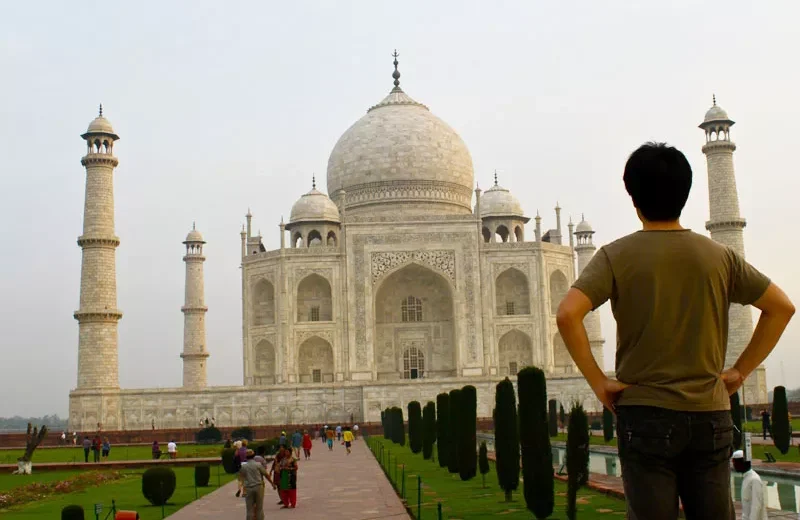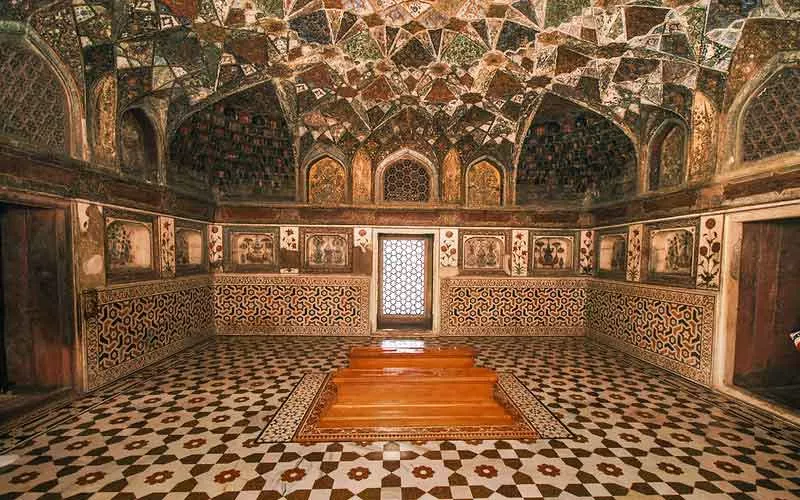Discover Agra: Beyond the Taj Mahal
If you’re planning a trip to Agra, you’re in for something truly special.
This city isn’t just about the Taj Mahal — it’s a living tapestry of history, architecture, culture, and flavor that beautifully captures the essence of India.
Part of the iconic Golden Triangle (along with Delhi and Jaipur), Agra was founded by Sultan Sikandar Lodi in 1504 and later flourished under Mughal rule. Set along the serene banks of the Yamuna River, the city still whispers stories of emperors, artisans, and eternal love.
You’re absolutely right — Agra’s magic lies not only in its monuments but also in its soul. Every corner tells a tale of royal grandeur, intricate craftsmanship, and timeless beauty.
Whether you’re here for a day or two, Agra promises unforgettable sights, vibrant culture, and rich flavors. So let’s dive in and explore the best things to do in Agra — to help you experience its perfect blend of history, architecture, and local charm.
Top Attractions and Must-Visit Places in Agra
The Iconic Taj Mahal
No trip to Agra is complete without experiencing the breathtaking beauty of the Taj Mahal — the world’s greatest monument to love. Commissioned in 1632 by Emperor Shah Jahan in memory of his beloved wife Mumtaz Mahal, this UNESCO World Heritage Site is far more than a masterpiece in marble — it’s a story carved in stone.
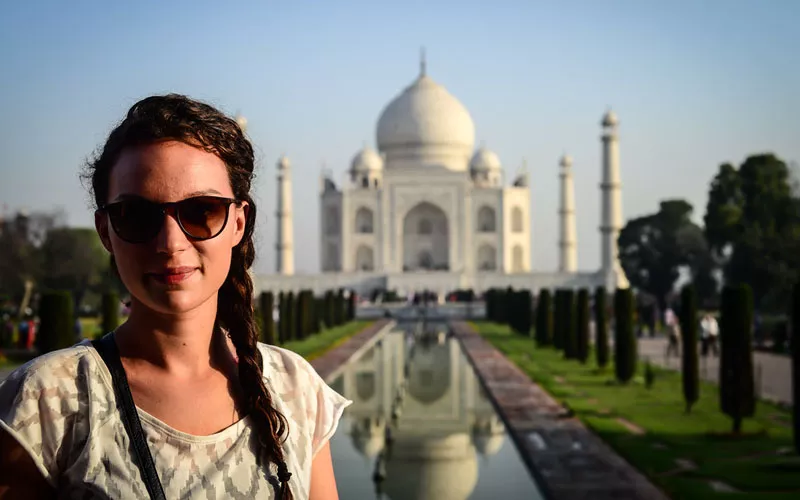
As the day unfolds, the Taj reveals its many moods — soft pink at sunrise, brilliant white under the afternoon sun, and glowing silver in the moonlight. Each moment feels like seeing a different monument altogether. Take a closer look at the exquisite Pietra Dura inlay work, where semi-precious stones form delicate floral patterns — a true testament to Mughal craftsmanship.
💡 Insider Tip: Arrive early at the East Gate before dawn to enjoy the serene sunrise and avoid crowds. For a deeper connection, hire a licensed local guide to uncover the fascinating stories, hidden details, and symbolism behind this eternal monument of love.
Agra Fort – The Red Sandstone Marvel
Once the grand seat of Mughal power, Agra Fort stands as a striking symbol of strength, artistry, and royal grandeur. Built from rich red sandstone, this UNESCO World Heritage Site was the main residence of the Mughal emperors until 1638 — a place where history truly comes alive within its mighty walls.

Walking through its vast courtyards and elegant chambers, you can almost imagine the echoes of royal gatherings and courtly intrigue. The fort is home to architectural gems like the Diwan-i-Aam (Hall of Public Audience) and the Diwan-i-Khas (Hall of Private Audience) — each reflecting the sophistication and power of the Mughal era.

In a poignant twist of history, Emperor Shah Jahan spent his final years imprisoned here by his son, Aurangzeb, gazing across the Yamuna River toward the Taj Mahal, where his beloved Mumtaz Mahal rested. That very view from the Mussamman Burj remains one of the most moving sights in Agra.
💡 Insider Tip: Carry a valid ID to enter and pack light — security checks are strict. Visit in the early morning or late afternoon for softer light and fewer crowds to truly absorb the fort’s majestic beauty.
Tomb of Akbar – The Visionary Emperor Who United India
Located in Sikandra, on the outskirts of Agra, the Tomb of Akbar beautifully reflects the emperor’s vision of unity and harmony. Its design is a graceful blend of Hindu, Islamic, and Persian architecture, symbolizing Akbar’s belief in inclusivity and cultural coexistence.
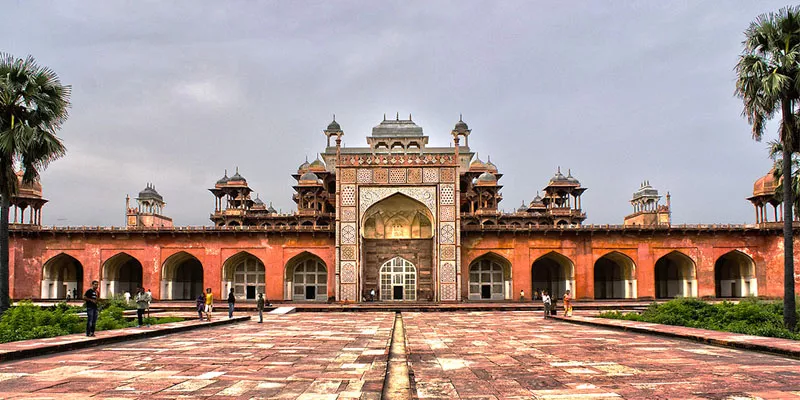
Surrounded by peaceful gardens and adorned with intricate stone carvings, the monument radiates a calm, reflective atmosphere — a fitting tribute to one of India’s most enlightened rulers. Though often overlooked by visitors focused on the Taj Mahal, Akbar’s tomb offers a quieter, more spiritual experience for those who take the time to explore it.
This site is not just a mausoleum — it’s a celebration of Akbar’s progressive spirit. Visiting it provides insight into the Mughal era’s artistry, philosophy, and the emperor’s dream of a unified India that transcended religion and culture.
💡 Insider Tip: Plan your visit in the early morning or late afternoon when the gardens are at their most serene and the marble glows beautifully in soft light. Don’t miss the intricate gateway, inspired by Fatehpur Sikri’s Buland Darwaza, and keep an eye out for the playful deer that roam the grounds.
Tomb of Itimad-ud-Daulah – The Elegant “Baby Taj”
Affectionately known as the “Baby Taj”, the Tomb of Itimad-ud-Daulah is one of Agra’s most exquisite gems and a must-see for lovers of art and history. Built between 1622 and 1628 by Empress Nur Jahan in memory of her father, Mirza Ghiyas Beg, this Mughal-era mausoleum is often seen as the architectural blueprint for the Taj Mahal.

Set gracefully on the western bank of the Yamuna River, the tomb stands on a red sandstone platform surrounded by symmetrical Persian-style gardens and water channels. Unlike the grand scale of the Taj, the Baby Taj’s charm lies in its delicate beauty and refined detail.
Crafted entirely from white marble, it was the first Mughal monument to feature such extensive use of Pietra Dura — an intricate inlay technique using semi-precious stones to create floral and geometric designs. The walls shimmer with tiny mosaics of onyx, jasper, topaz, and lapis lazuli, giving the monument an almost jewel-box appearance. Inside, the central chamber holds the resting places of Itimad-ud-Daulah and his wife, Asmat Begum, surrounded by richly painted ceilings and latticed marble screens.
Why Visit: Often described as a “miniature masterpiece,” the Baby Taj offers a peaceful and intimate experience compared to the grandeur of the Taj Mahal. Its artistic precision, serene setting, and pioneering design give visitors a glimpse into the Mughal craftsmanship that inspired one of the world’s greatest wonders.
💡 Insider Tip: Visit early in the morning or late afternoon for the best light on the marble’s intricate carvings. Combine your visit with a stop at Mehtab Bagh, just across the river, for a stunning view of the Taj Mahal at sunset.
Fatehpur Sikri – The Lost City of Emperor Akbar
About 40 km from Agra, the majestic Fatehpur Sikri stands as a haunting reminder of the Mughal Empire’s grandeur and ambition. Built in 1571 by Emperor Akbar the Great, this once-thriving capital was intended to be the heart of his empire — a city that reflected power, faith, and architectural brilliance. Yet, just a decade later, it was mysteriously abandoned, earning it the title of India’s “Ghost City.”
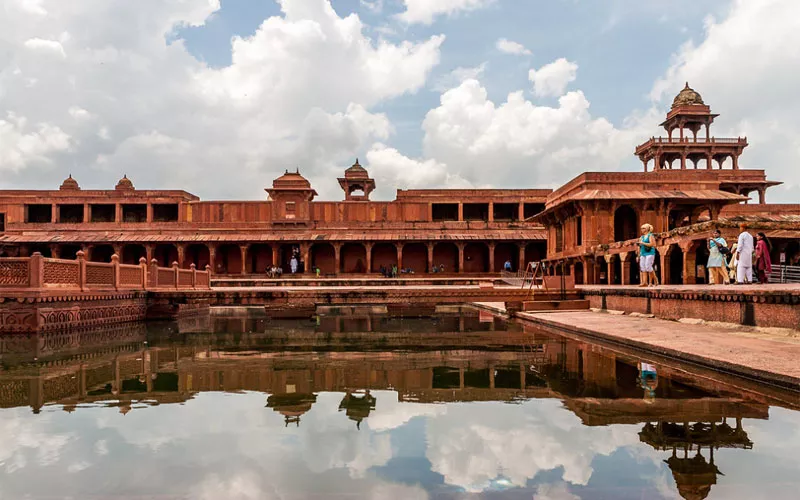
Wandering through its perfectly preserved palaces, courtyards, and gateways feels like stepping back in time. Highlights include the Panch Mahal, a five-story open pavilion with 176 carved columns; the Diwan-i-Khas, where Akbar held private audiences and crafted his policies of tolerance; and the magnificent Buland Darwaza, one of the tallest gateways in the world, built to commemorate Akbar’s victory over Gujarat.
Equally mesmerizing is the Jama Masjid, one of India’s largest mosques, and the serene Tomb of Salim Chishti, where devotees still come to pray for blessings — a living link between the city’s glorious past and spiritual present.
Why Visit: Fatehpur Sikri isn’t just a historical site — it’s a story frozen in red sandstone. Each arch and courtyard speaks of Akbar’s vision for unity among cultures and religions. The blend of Persian, Islamic, and Hindu design makes it a must-visit for history and architecture lovers alike.
💡 Insider Tip: Plan a half-day trip from Agra and go early in the morning or late afternoon to avoid the midday heat. Wear comfortable shoes, as the complex is vast, and carry water. A local guide can help bring the ruins to life with fascinating tales of Akbar’s reign and the city’s mysterious abandonment.
Mehtab Bagh – The Moonlit Garden of the Taj
Across the Yamuna River from the Taj Mahal lies Mehtab Bagh, a tranquil garden that offers one of the most enchanting views of the monument. Literally translating to “The Moonlight Garden,” Mehtab Bagh was designed during the Mughal era as part of a perfect geometric alignment with the Taj — a reflection garden meant to be admired under the moon’s soft glow.

Today, it’s a peaceful escape from Agra’s bustling streets. As you walk through the manicured lawns, the Taj Mahal stands perfectly framed across the river, its reflection shimmering in the water channels — a photographer’s dream, especially at sunset.
Why Visit: If you want to admire the Taj Mahal from a serene and crowd-free spot, Mehtab Bagh is the place. It’s an ideal spot for sunset photography, quiet contemplation, or simply soaking in the romance that defines Agra.
💡 Insider Tip: Visit just before sunset for magical golden-hour views of the Taj Mahal. Bring your camera or phone tripod for perfect reflection shots. It’s also a wonderful place to unwind after exploring the main monuments — pack a light snack or chai and enjoy the peaceful ambiance.
Flavours of Agra – A Journey Through Mughal Taste and Tradition
Agra isn’t just a feast for the eyes — it’s a paradise for food lovers. Once the heart of the Mughal Empire, the city still carries the flavors of its royal kitchens, where recipes were infused with aromatic spices, dry fruits, and a generous dash of indulgence.
Start your day like a local with Bedai and Jalebi, a traditional breakfast combo that’s both spicy and sweet. As you wander the streets, treat yourself to Agra’s famous Petha — a soft, translucent sweet made from ash gourd — or snack on Dalmoth, a spicy lentil mix that perfectly balances crunch and flavor.
For an authentic experience, join a street food walk through the bustling lanes near Sadar Bazaar or Kinari Bazaar. From sizzling kachoris to fragrant chai, every bite tells a story of the city’s rich culinary heritage.
Why Visit: Agra’s food is a reflection of its history — rich, diverse, and deeply satisfying. Sampling the city’s street food is one of the most enjoyable and memorable ways to experience its culture.
💡 Insider Tip: Stick to popular local spots with steady crowds, and don’t hesitate to ask vendors for recommendations. Try a guided food tour by Tuk Tuk — it’s safe, fun, and lets you taste Agra like a true local.
Shopping in Agra – Where Heritage Meets Handcraft
Agra is not just about monuments — it’s also a city of artisans. The same hands that once crafted marble masterpieces for the Mughals now shape stunning souvenirs for travelers.
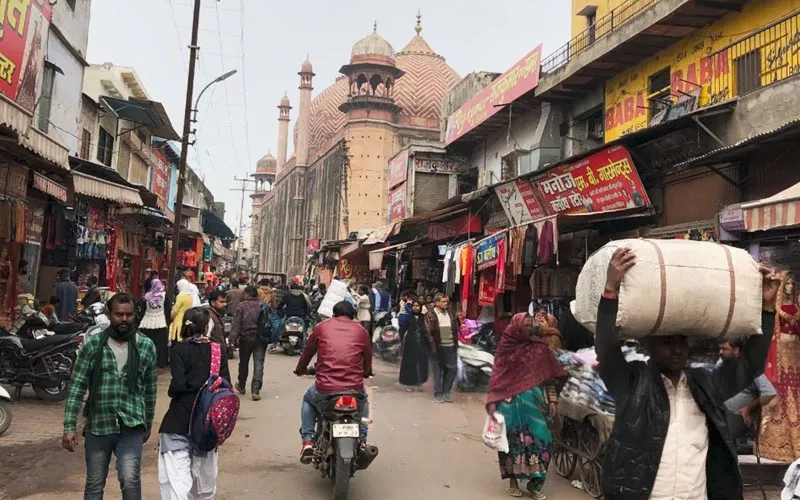
Wander through Sadar Bazaar for leather goods, Kinari Bazaar for jewelry and textiles, and Subhash Bazaar for silk sarees and embroidery. You’ll also find delicate marble inlay work, miniature Taj Mahal replicas, colorful rugs, and handcrafted ornate boxes — each item reflecting Agra’s timeless artistry.
Why Visit: Shopping in Agra is like walking through a living art gallery. Every market tells a story — of craftsmanship, tradition, and pride. It’s the perfect way to take a piece of Agra home with you.
💡 Insider Tip: Bargaining is part of the fun! Stay polite and friendly — vendors appreciate good humor. For authentic quality, buy from government emporiums or verified artisan cooperatives.
Unique Experiences in Agra – Beyond the Monuments
If you think Agra is only about marble and history, think again! The city has plenty of unique experiences that bring its stories to life.
1. Watch the “Mohabbat the Taj” Show
This musical drama at the Kalakriti Cultural & Convention Center retells the love story of Shah Jahan and Mumtaz Mahal through stunning sets, colorful costumes, and soulful music. It’s a mesmerizing way to experience the legend behind the Taj.
2. Take a Heritage Walking Tour
Walk through Agra’s old lanes with a local guide and discover the city’s heartbeat — spice markets, hidden courtyards, temples, and street-side chai stalls. It’s a sensory journey that lets you experience Agra beyond the postcards.
3. Visit a Marble Inlay Workshop
Witness artisans practicing the centuries-old Pietra Dura technique, inlaying semi-precious stones into marble — the very art used in the Taj Mahal. Watching their precision and patience is nothing short of magical.
4. Enjoy a Sunset View from the Yamuna Riverbank
Take a peaceful boat ride at dusk for an unforgettable view of the Taj Mahal glowing in the fading light — a moment of serenity that stays with you long after you leave.
💡 Insider Tip: Book experiences through trusted local guides or certified platforms. Many offer combined packages that include walking tours, food tastings, and cultural shows — a great way to see the real Agra in a single day.
Final Thought: The Soul of Agra
Agra is far more than the Taj Mahal — it’s a living story of art, flavor, and human connection. Whether you’re savoring Petha in a local market, chatting with artisans over chai, or watching the Taj turn golden at sunset, every moment here feels timeless.
Come for the monuments, stay for the magic — because Agra isn’t just a destination; it’s an experience that stays in your heart forever.

